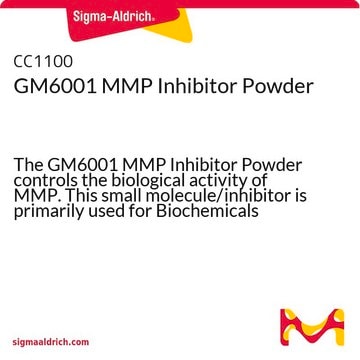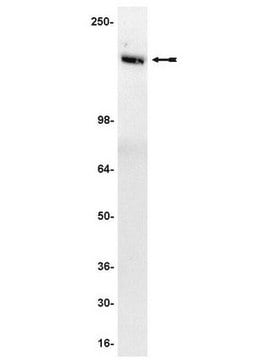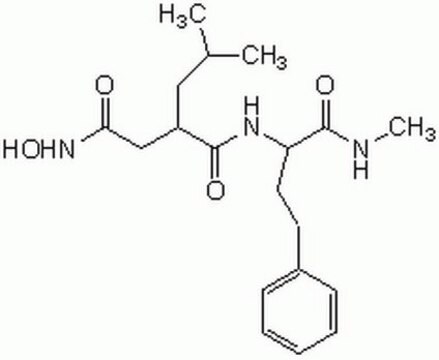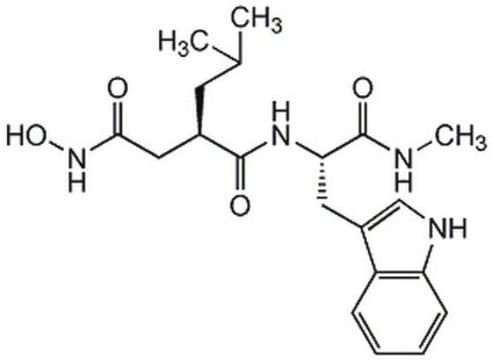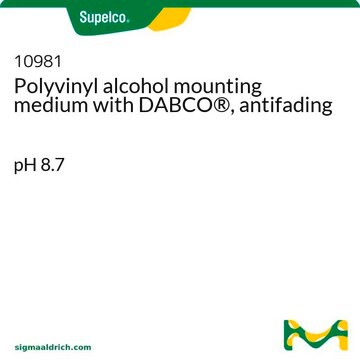444250
MMP Inhibitor I
The MMP Inhibitor I controls the biological activity of MMP. This small molecule/inhibitor is primarily used for Protease Inhibitors applications.
Synonyme(s) :
MMP Inhibitor I, FN-439
Se connecterpour consulter vos tarifs contractuels et ceux de votre entreprise/organisme
About This Item
Formule empirique (notation de Hill):
C23H34N6O6
Poids moléculaire :
490.55
Code UNSPSC :
12352200
Nomenclature NACRES :
NA.77
Produits recommandés
Niveau de qualité
Pureté
≥95% (HPLC)
Forme
solid
Puissance
1 μM IC50
Fabricant/nom de marque
Calbiochem®
Conditions de stockage
OK to freeze
Couleur
white
Solubilité
water: 1 mg/mL
Conditions d'expédition
ambient
Température de stockage
−20°C
Description générale
A tetrapeptidyl hydroxamic acid that inhibits MMP-1 and MMP-8 (IC50 = 1.0 µM), MMP-9 (IC50 = 30 µM) and MMP-3 (IC50 = 150 µM). Retains its activity even after prolonged incubation with PRONASE Protease (Cat. Nos. 53702 or 537088) or human granulocyte elastase.
A tetrapeptidyl hydroxamic acid that inhibits interstitial and granulocyte collagenases (MMP-1 and MMP-8; IC50 = 1 µM), granulocyte gelatinase (MMP-9; IC50 = 30 µM), adn skin fibroblast stromelysin (MMP-3; IC50 = 150 µM). Retains its activity even after prolonged incubation with PRONASE Protease (Cat. No. 53702) or human neutrophil elastase.
Actions biochimiques/physiologiques
Cell permeable: no
Primary Target
MMP-1, MMP-8
MMP-1, MMP-8
Product does not compete with ATP.
Reversible: no
Avertissement
Toxicity: Standard Handling (A)
Séquence
4-Abz-Gly-Pro-D-Leu-D-Ala-NH-OH [Abz = aminobenzoyl]
Reconstitution
Following reconstitution aliquot and freeze (-20°C). Stock solutions are stable for up to 1 month at -20°C.
Autres remarques
Hagemamn, T., et al. 2004. Carcinogenesis25, 1543.
Odake, S., et al. 1994. Biochem. Biophys. Res. Commun. 199, 1442.
Odake, S., et al. 1994. Biochem. Biophys. Res. Commun. 199, 1442.
Informations légales
CALBIOCHEM is a registered trademark of Merck KGaA, Darmstadt, Germany
Code de la classe de stockage
11 - Combustible Solids
Classe de danger pour l'eau (WGK)
WGK 1
Point d'éclair (°F)
Not applicable
Point d'éclair (°C)
Not applicable
Certificats d'analyse (COA)
Recherchez un Certificats d'analyse (COA) en saisissant le numéro de lot du produit. Les numéros de lot figurent sur l'étiquette du produit après les mots "Lot" ou "Batch".
Déjà en possession de ce produit ?
Retrouvez la documentation relative aux produits que vous avez récemment achetés dans la Bibliothèque de documents.
Les clients ont également consulté
Jörg Weiske et al.
Methods in molecular biology (Clifton, N.J.), 289, 175-192 (2004-10-27)
In epidermal cells desmosomes represent major sites of basolateral cell-cell contacts that play an important role for epidermal homeostasis. Excess or damaged cells are often removed by apoptosis. To release apoptotic cells from the tissue, intercellular contacts have to be
Notre équipe de scientifiques dispose d'une expérience dans tous les secteurs de la recherche, notamment en sciences de la vie, science des matériaux, synthèse chimique, chromatographie, analyse et dans de nombreux autres domaines..
Contacter notre Service technique



